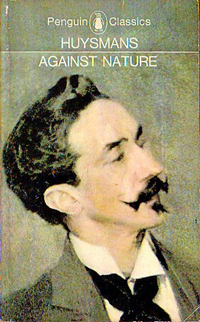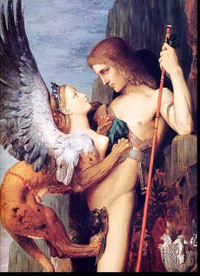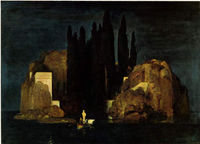A sphinx-like mongrel chasing down decadent grave-robbers? Yeah, I’m sold. I loved this story so much I called all my friends to rave mad about it. But rather than preach to the choir here, I thought I would nerd out about the Decadents (a.k.a. Symbolism), whose heavy influence in this story won my heart.
Symbolism was an art movement that spanned most of Europe and the United States in the last few decades of the nineteenth century. It began in France, under the influence of Mallarmé and Baudelaire (both who translated and advocated Poe in France), as a literary movement, but immediately carried over into the visual arts of Gustav Moreau, Odilon Redon, and Arnold Böcklin. Symbolist theory began to emerge not only under the guidance of Mallarmé, but also in conjunction with the rejection of the Naturalist and Realist schools. These two schools advocated in both writing and fine art the depiction of nature and life as it is seen, sans exaggerations. These movements were more concerned with social issues, prescribing to the positivist trend that boomed with the Industrial Revolution.
Positivism called for a world based upon reason and technology, and only acknowledged “…one level of reality: nature,” as Michael Gibson writes in his Taschen coffee table book Symbolism. In Positivism, dreams were only for those who slept, and the sleeper was Symbolism.
Up until 1886, the genesis of Symbolism was forming under the guise of “Decadence.” In Paul Bourget’s “Baudelaire and the Decadents,” written in 1881, he espouses upon how artistic ideals should always transcend moral uncouthness. He calls upon the writer and artist to forget Naturalism and Realism for “the better cause,” for “the cause” was wasted in those mediums. He recommends turning to a life of decadence, the true artistic paradigm. The decadence of society is a result of serious artists retreating into their own souls, that is where their true art lays: “The word decadence frequently refers to the state of a society that produces too many individuals ill-suited to the work of the community…. If citizens in a time of decadence are inferior as toilers for the grandeur of the country, are they not also superior as artists delving into the depth of their own souls?”1
By this definition, artists were to hang-up their altruistic hat and don the sleeping-cap to travel into the repressed realm of dreams and nightmares.
 Perhaps the most popular Decadent/Symbolist literary work is Against Nature (A Rebours) by J.K. Huysmans. It and its protagonist Des Esseintes are best described in Oscar Wilde’s The Picture of Dorian Grey:
Perhaps the most popular Decadent/Symbolist literary work is Against Nature (A Rebours) by J.K. Huysmans. It and its protagonist Des Esseintes are best described in Oscar Wilde’s The Picture of Dorian Grey:
It was a novel without a plot and with only one character, being, indeed, simply a psychological study of a certain young Parisian who spent his life trying to realize in the nineteenth century all the passions and modes of thought that belonged to every century except his own, and to sum up, as it were, in himself the various moods through which the world-spirit had ever passed, loving for their mere artificiality those renunciations that men have unwisely called virtue, as much as those natural rebellions that wise men still call sin.
It all sounds lofty, but it can all be boiled down to this: Des Esseintes, as well as Dorian Grey, hunted the newest thrills simply to fend off ennui. So, too, did “The Hound’s” narrator and his companion St. John, but art and philosophy was not enough:
Only the somber philosophy of the decadents could help us, and this we found potent only by increasing gradually the depth and diabolism of our penetrations. Baudelaire and Huysmans were soon exhausted of thrills, till finally there remained for us only the more direct stimuli of unnatural personal experiences and adventures. It was this frightful emotional need which led us eventually to that detestable course which even in my present fear I mention with shame and timidity—that hideous extremity of human outrage, the abhorred practice of grave-robbing.
Just like Lovecraft breaks philosophically with Poe in “The Outsider,” so too does he twist the Decadents:
Our museum was a blasphemous, unthinkable place, where with the satanic taste of neurotic virtuosi we had assembled an universe of terror and decay to excite our jaded sensibilities. It was a secret room, far, far, underground; where huge winged daemons carven of basalt and onyx vomited from wide grinning mouths weird green and orange light, and hidden pneumatic pipes ruffled into kaleidoscopic dances of death the lines of red charnel things hand in hand woven in voluminous black hangings. Through these pipes came at will the odors our moods most craved; sometimes the scent of pale funeral lilies; sometimes the narcotic incense of imagined Eastern shrines of the kingly dead, and sometimes—how I shudder to recall it!—the frightful, soul-upheaving stenches of the uncovered-grave.
This meticulous attention to sensory recalls Des Esseintes house, where every color and fabric was chosen to create a sensation. So zealous was Des Esseintes about achieving pure art, he had a tortoise shell fitted with fine gemstones just so he could watch the sunshine’s effect as it waddled around the living room until the overburdened tortoise died. “The Hound’s” imagined and fetishized experiences of death and afterlife go beyond Des Esseintes, who focused more on life and an inner existence. But “The Hound’s” characters are bored with all that and take solace in crafting their idea of a microcosmic necropolis—made sacred by the characters’ meticulous meditations and exploits, what the narrator calls their most “exquisite form of aesthetic expression.”

Lovecraft also takes the Decadent’s mascot, the sphinx, usually depicted as a sensual and feline woman, and warps it into a pugnacious hell-hound: “In the coffin lay an amulet…. It was the oddly conventionalized figure of a crouching winged hound, or sphinx with a semi-canine face…. The expression of its features was repellent in the extreme, savoring at once of death, bestiality and malevolence.”
Lovecraft also inducts the beast into his emerging mythos pantheon: “…we recognized it as the thing hinted of in the forbidden Necronomicon of the mad Arab Abdul Alhazred; the ghastly soul-symbol of the corpse-eating cult of inaccessible Leng, in Central Asia.”
In that lovely use of “negative space,” where Lovecraft describes the indescribable, the hound’s features are ambivalent, but I imagine it as some sort of were-sphinx incarnation of the corpse they robbed.
With the dark palette of Symbolist art, the blasé ennui and hedonism of the Decadents, paired with Lovecraft’s unique weird, there is no way I can turn back. I feel compelled to keep walking steadfastly up the dusty path leading to Arkham. In my next reading, I will tackle even more “negative space” with “The Color Out Of Space,” and meet this legendary elder god everyone keeps going on about in “The Call of Cthulhu.”
1 Bourget, Paul. “Baudelaire and the Decadents”. Dorra, Henri, Ed. Symbolist Art Theories: A Critical Anthology. Berkeley: University of California Press. 1994. Pg. 130.
S.J. Chambers is an articles editor at Strange Horizons. In addition to that fine publication, her work has also appeared in Fantasy, Bookslut, Yankee Pot Roast, and The Baltimore Sun’s Read Street blog. When she isn’t writing, she is excavating artifacts as Master Archivist for Jeff VanderMeer’s The Steampunk Bible.










